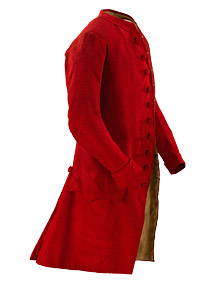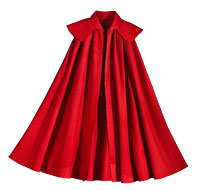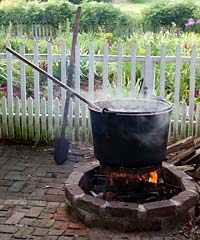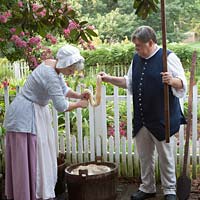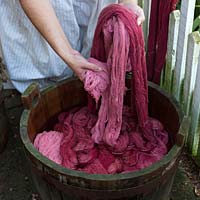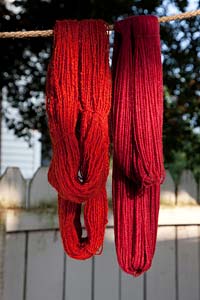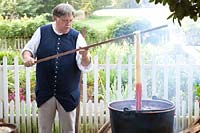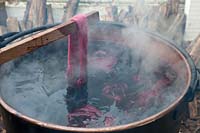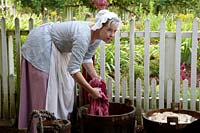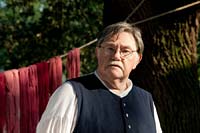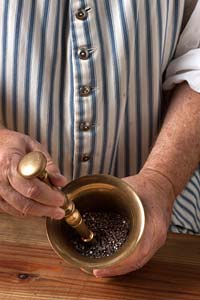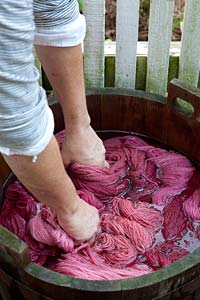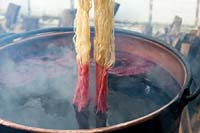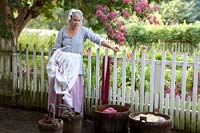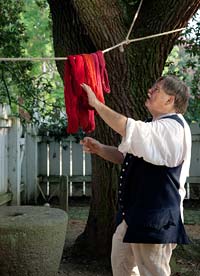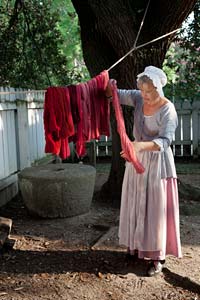Online Extras
Extra Images

Close-up of cochineal bugs, source of the carmine color prized by kings, churchmen, and the military.
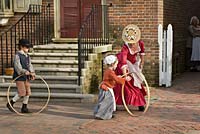
Two tradesmen in eighteenth-century Williamsburg dyed cloth and clothing for residents seeking to brighten their attire.
Putting the Red in Redcoats
by Mary Miley Theobald
The cochineal is an odd sort of bug. The female lives her life in a spot on a nopal cactus, or prickly pear. As soon as she hatches, she buries her mouth in the cactus pad and starts sucking. She will live, breed, and die on that spot, parasitically attached to the cactus beneath a bit of cottony fluff. The males have wings and lead more exciting lives, flying about in search of females. But the price for their mobility is a one-week lifespan—their mouthparts deteriorate, and they starve. The female, not much bigger than the head of a pin, lays her eggs on the cactus and continues to feed. Her offspring, if they are not blown by the wind to another nopal, crawl only as far as they must to find a place to dig in, and the cycle repeats.
A bug that never moves makes an easy mark for predators, so Mother Nature protects the females by endowing them with carminic acid, a chemical that some predators find offensive. As it happens, carminic acid is also a vibrant red colorant, ten times more potent than the nearest competitor, and colorfast on fabric when used with the right mordants. That once made the tiny cochineal worth more than her weight in gold.
For more than a century, inexpensive synthetic dyes have been able to create any color on the color wheel, and the world has forgotten the message of power and wealth that intense color once conveyed. People from the past craved bright colors, but only the rich and royal could afford expensive dyes and the fabrics that showed them off. So tight was the link between the aristocracy and color that in many societies, laws restricted strong colors like scarlet or purple to the nobility, just in case some nouveau riche lout was tempted to dress above his station. Renaissance Europeans would have considered today's dress-for-success colors—black, beige, grey, and other subdued shades—fit only for paupers.
Red and its close cousin purple were the most coveted of colors. Down the centuries, reds and reddish purples became the acknowledged color of royalty throughout most of the world. Chinese and Persian rulers preferred red. The togas of Roman senators bore a red band. The Catholic Church took red as a symbol of its authority, using a red cross on a white shield as its emblem and dressing its cardinals in scarlet robes. The British were not alone in dressing their military officers in red uniforms. Its rarity and its link to status made good red dye almost priceless.
Of the substances that create reddish dyes, none are as bright or as colorfast as cochineal. Deep inside the Paleolithic caves in southern France and Spain are paintings made from red ochre, which gets its hue from iron rich clay. Cinnabar, a toxic mineral discovered a thousand years ago in Asia, makes a good paint too, but neither ochre nor cinnabar is absorbed well by fabric. Egyptians, Romans, and later Europeans used madder for their reds, a tricky dye that reached its brightest manifestation with the Turks, in whose hands the process took months and more than a dozen steps. The Italians developed the best pre-cochineal red in the Middle Ages from kermes, a Mediterranean insect similar to cochineal. Difficult to gather and to work with, kermes produced a decent red dye for those who knew its secrets, although the cost might well be more than a king could afford.
Spanish conquistadores in Aztec Mexico were astonished at the intensity and abundance of red on native fabrics. They learned that Emperor Moctezuma's subjects paid part of their annual tribute in bags of cochineal. It seems obvious that they would think of profiting from the dye themselves, but bugs and dye were beneath the dignity of gentlemen soldiers in hot pursuit of gold and silver. A couple decades passed before Spanish merchants arrived in Mexico and stepped into the breach. Soon these merchants were buying cochineal from native middlemen and shipping thousands of pounds home to Seville and from there—with huge markups—to the rest of Europe. Within a few years, the little dried bugs were second only to silver as Spain's most valuable New World commodity.
Except that no one outside Spain and Mexico knew they were little dried bugs. And the Spanish were determined to keep it that way. Just as the Chinese guarded the secret of porcelain for centuries, the Spanish maintained their stranglehold on Europe's most valuable dye. For three centuries, the English, French, and Dutch resorted to espionage, piracy, bribery, and theft to learn the secret of this fabulous dye and break Spain's monopoly, to no avail.
Amy B. Greenfield, author of A Perfect Red, compares the textile industry of that time to today's computing or biotech industries: "a highstakes industry rife with intense rivalries and cutthroat competition—an industry with the power to transform society." Textile production was a complicated and profitable concern requiring a skilled work force. A nation that shipped off unfinished fabric to another country to dye was handing its rivals good jobs and the bulk of the profits. Cochineal was critical to a country's industrial success.
One way to get cochineal was to steal it. Pirates and privateers who stalked Spanish treasure galleons succeeded in snatching their rich cargoes all too often. The largest haul on record was that of the Earl of Essex, Queen Elizabeth's hotheaded young favorite, who, with Walter Ralegh, brought home three Spanish ships in 1597 carrying twenty-seven tons of cochineal. The queen took her customary 10 percent, and England had years' worth of dye for its cloth industry. In his Generall Historie, John Smith told of his capture by French privateers, who forced him to work with them for two months. During that time they seized a Spanish ship with "fiftie Chests of Cutchanele, fourteene Coffers of wedges of Silver," and much other treasure belonging to the Spanish king.
But pirates were unreliable suppliers. Better to produce one's own cochineal in one's own colonies. English geographer Richard Hakluyt wrote in his Voyages of 1582 about his hopes of finding "the berrie of Cochenile" in America. The Virginia Company of London had hopes for its new settlement at Jamestown. Two years after its founding, publicist Robert Johnson wrote encouragingly to investors, "there is undoubted hope of finding Cochinell, the plant of rich Indico, Graine-berries, Beaver Hydes, Pearles, rich Treasure, and the South sea leading to China." He would be disappointed on all counts.
Finding cochineal would have been easier if the English had known what it was. To the naked eye, the dried bits of cochineal look like tiny peppercorns. Some said cochineal was a seed; others said it was an insect or dried worm. Some had it both ways, calling it "wormberry." In an age when rotten meat was believed to spawn maggots and clams were thought to grow out of sand, spontaneous generation was a reasonable explanation for any mysterious form of life. Cochineal, some said, was a cactus berry that turned into a red worm. Hakluyt, collector and editor of volumes of travel tales, wrote in his Principal Navigations, "The Cochinilla is not a worme, or a flye, as some say it is, but a berrie that groweth upon certaine bushes in the wilde fielde." French explorer Samuel de Champlain said in his Narrative, "It comes from a fruit the size of a walnut which is full of seed within . . . and is esteemed as gold and silver."
The Spanish encouraged the confusion. They also prohibited the export of live cochineal from Mexico, censored information about it, and forbade anyone to go to Mexico without a permit—which they would not grant foreigners.
Even the first microscopes, which appeared in the early 1600s, did not settle the dispute. The Dutch lens maker Antonie van Leeuwenhoek shared his discoveries, if not his secret, for making good lenses with members of the British Royal Society. Requested in 1685 by the chemist Robert Boyle to examine some grains of cochineal, he declared them seeds—a surprising mistake for someone as experienced as Leeuwenhoek. Boyle took his word for it, until he heard from another, highly reputable source that "the Cochineal is really the hindmost part or tail of the fly." He pressed Leeuwenhoek to look again. Primed this time to look for an insect part, Leeuwenhoek changed his mind. "Each tiny grain is a part of a little animal," he said. The cochineal bits were really "females whose body is full of eggs."
That should have settled the matter, but communication and skepticism being what they were, doubts persisted throughout most of the eighteenth century. There were roughly seventy thousand cochineal granules to a pound. How could humans possibly catch so many tiny flying insects and then pull off their legs, wings, and heads? Perhaps it was just those nefarious Spanish planting false information.
Because Spain prohibited foreigners from traveling in its colonies, there was no way to find out how cochineal was produced. The key was the Mexican peasant whose Mayan ancestors had bred the wild cochineal to become a larger, more productive dye producer. Indeed, whenever some European managed to discover cochineal in another part of South America, it turned out to be the unsatisfactory wild variety with disappointing properties. Mexican peasants who nurtured the delicate insect in their nopal gardens could eke out as many as three harvests a year, scraping them off the cactus with a brush and drying them in various ways to produce various colors.
Luck was with the Spanish when it came to protecting their secret: cochineal is fragile and finicky. It only grew well in certain parts of Mexico, and it only eats nopal. A flash of cold weather, a hard rain, or the wrong elevation brought death. So even when the occasional French or English spy got his hands on live cochineal, the bugs perished on the way to Europe. Europeans remained dependent upon Spain for their favorite red dye for three hundred years.
Colonial Virginians imported their fabric from England. Most of it came already dyed—that was, after all, the main principle of the mercantile theory, where the mother country shipped manufactured goods to the colonies in return for raw materials. This meant there was little call for dyers or dye in Virginia. Still, Williamsburg had at least two men who dabbled in dying: William Dubberly, a hatter who advertised in 1737 that he also dyed silks and woolens "at reasonable prices," and William Page, who cleaned and dyed clothing for Williamsburg's well-to-do. These men, says Max Hamrick, Colonial Williamsburg's weaver and dyer, were probably changing the color of dresses: "Change the trim and dye the dress, and you have a new dress." Not until the nonimportation agreements of the late 1760s did Virginia start its own fabric industry: "After the war started, the Williamsburg Manufactory, located just outside Williamsburg, began producing cloth from linen and hemp."
At Hamrick's Historic Area weaving shop, he and his assistants dye yarns and cloth once a week, January through March, and at other times during the year for special programs. For reds, they use cochineal and madder. Hamrick says that both dyes were used to put the red in Redcoats. The British government supplied their soldiers' with uniforms that were dyed with madder because it was cheaper. Officers, who supplied their own uniforms, preferred the brighter red of cochineal for their jackets.
Cochineal's primary customers were the fabric dyers, but the little dried bugs had value to other professions. Cochineal was readily available in eighteenth-century Williamsburg from shopkeeper William Prentis on the main street. Colonists who bought cochineal from Prentis Store probably needed small amounts to color food and beverages. Frank Clark and Dennis Cotner of Historic Foodways use cochineal today in their cooking at the Palace and Randolph kitchens. Period cookbooks like Hannah Glasse's Art of Cookery, published from 1747 through 1843, and M. Radcliffe's Domestic Cookery of 1823 call for cochineal whenever a red color is desired in food or beverages. To make sugared almonds red, Radcliffe directs the cook to "Mix about a tea-cupful of water with sufficient cochineal to produce a good red." The almonds "will be of a beautiful and lively rosaceous or deep crimson colour." The 1754 Dictionary of Arts and Sciences instructs "the good housewife" how to make refreshing coolers with lemonade, wine, and spring water, "adding a little cochineal, sugar, or rose-water." Cotner occasionally swaps his spoon for a paintbrush to decorate marzipan delicacies with cochineal for the governor's dining table. He dissolves the powdered cochineal in wine or sherry and filters out the flecks. "It's very bitter, so I can't use a lot," he says.
Artists found that cochineal made a bright and long-lasting, if expensive, scarlet pigment. Leather workers sometimes stained their leather with the red dye. Cochineal was, and still is, used in the manufacture of such cosmetics as lipstick and rouge.
Doctors, too, used cochineal for coloring. Robyn Kipps, supervisor of the Pasteur and Galt Apothecary, said that some doctors and apothecaries believed cochineal would bring on a sweat, energize spirits, and prevent the effects of a poison taken orally, but Doctor Pasteur used it only as a coloring agent. Perhaps he learned this from the pharmacology book that he owned, The New Dispensatory, which says, "Cochineal has been strongly recommended as a sudorific, cardiac and alexipharmac: but practitioners have never observed any considerable effects from it . . . in medicine its principal use is as a colouring drug."
Apothecaries tended to order their supplies direct from London. James Carter, whose apothecary was at the Sign of the Unicorn's Horn, imported cochineal in 1758 and 1760 from the same London supplier that Galt and Pasteur used twenty years later.
The invention of artificial dyes in the late nineteenth century destroyed the market for cochineal. The new dyes were cheaper, more consistent, and simpler to use. Parts of the world that depended upon cochineal—the cultivation had spread to Guatemala and the Canary Islands—were devastated. Trade in cochineal almost disappeared.
But when the FDA banned Red Dye No. 2 in 1976, many food and cosmetics producers returned to cochineal, which is neither a toxin nor a carcinogen. Sometimes listed as carmine or E120, cochineal is the only natural red food coloring authorized by the FDA. It is added to jams, shrimp, candies, beverages, ice cream, sausages, juice, yogurt, cakes and icings, cookies, maraschino cherries, pie fillings, and other foods, as well as some pills, ointments, cough drops, rouge, and lipstick.
Today, cochineal is sold to the food and drug industry in liquid or powdered form, without the bug parts, minimizing the yuck factor. Vegetarians and animal rights groups may object, but it seems cochineal is back to stay.


